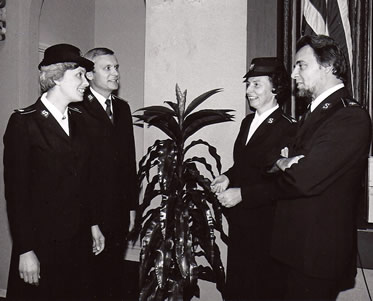John Larsson writes – May 2013:
Some of our best known songs are among those featured on this CD of favourites from the last four of the musicals that John Gowans and I wrote together. This fourth CD completes the series – a series that has a total of 115 tracks providing five hours of music from the musicals with accompanying lyric booklets.
Unlike the first three CDs in the series, which covered two musicals each, this CD has favourites from four musicals. This was always part of the plan for these four musicals are not as well known as the first six. White Rose was written for women’s ministries, Son of Man was initially published in the USA, Man Mark II was published only in that country, and The Meeting came at the tail-end of the era of our musicals. Yet we have always reckoned that they include some of our best songs.
Some of these songs have already become part of the Army’s repertoire of congregational songs – others may be new to listeners. But whether known or as yet unknown, may these songs bring inspiration.

Lieut-Colonels Freda and John Larsson with Lieut-Colonels Gisèle and John Gowans at the premiere of Son of Man in Los Angeles, June 1983.
White Rose
The musical is set in Paris and tells the true story of how the gift of a white rose transformed a woman’s life. Clare was in despair. Everything in life was going wrong for her. She then met some Salvationists who invited her to attend a meeting of the home league. At the end of the meeting the home league secretary had the inspiration of taking a white rose from the vase on the table and presenting it to Clare as a token of affection. When Clare took the white rose home its beauty and purity was in such a stark contrast to the neglected and run-down state of her home, that it eventually became the means of her conversion to Christ.
In consequence, the emblem of a white rose was for many years cherished by the home leagues in France as their signature emblem.
The musical was commissioned for the 70th anniversary of the home league, and its first performance was in the Royal Albert Hall, London, on 27 June 1977. It was later published by SP&S. It is the shortest of our musicals – perhaps a contributory reason for its widespread and continuing use not only by women’s ministries throughout the Army world but also by other groups.
Son of Man
The musical Son of Man explores the life, death and resurrection of Jesus from the angle of him being the embodiment of God as the man perfectly filled with the Spirit.
The musical was commissioned for the centenary congress of the USA Western Territory – where John and Gisèle Gowans were then serving – and was premiered in Los Angeles on 5 June 1983. It was first published by the USA Western Territory and later by SP&S in London.
Man Mark II
This musical was commissioned for the 1985 International Youth Congress held in Macomb, USA. In his introductory notes to the musical, John Gowans sets the scene:
‘Can the Creator of all things know what it is to feel disappointed over something? If he can, then he must have felt deeply disappointed with Adam – Man Mark I. But with a stroke of sublime genius that only the divine mind could produce, God introduced Man Mark II. This ‘second Adam’, the prototype of a new humanity, was simply called Christ, and the people who resembled him were called Christians.’
The musical shows these profound truths being worked out in a contemporary setting that fizzes with fun and energy – and where deep emotion is also felt.
The premiere of the Man Mark II took place in Macomb on 21 July 1985. The musical was later published by the USA Western Territory.
The Meeting
The musical The Meeting focuses on the lives and circumstances of a group of people who are attending an Army meeting. The key message of the musical is that the meeting which will transform the lives of these people is not the meeting at the hall but is a meeting with Christ.
The Meeting was commissioned for the 1990 International Congress held in London, UK. It was premiered in the Wembley Auditorium on Friday 29 June 1990. The musical was subsequently published by SP&S.
This was the last of the ten musicals that John Gowans and I wrote together, and it has been pleasing to see its continuing use by groups around the world.